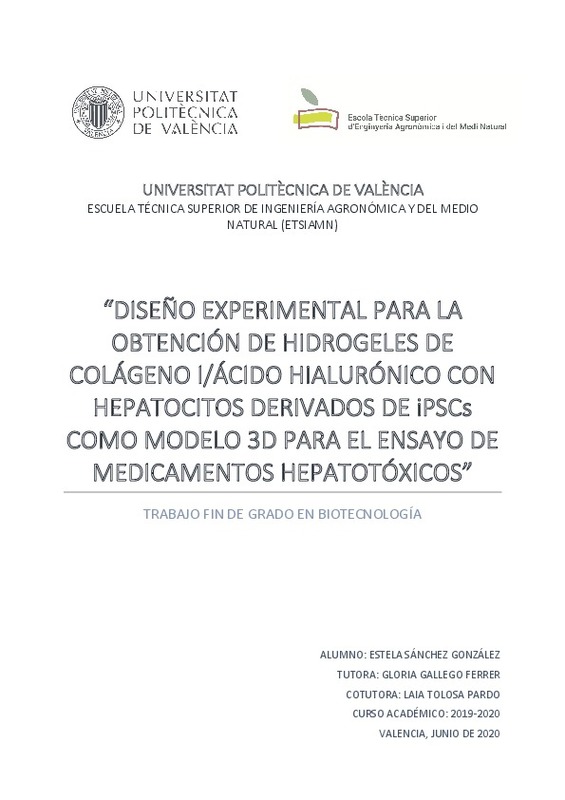|
Resumen:
|
[ES] El objetivo de este proyecto es el diseño experimental de la síntesis de hidrogeles como modelo 3D para el cultivo de células hepáticas de cara a su empleo como plataformas de hepatotoxicidad in vitro. Los materiales ...[+]
[ES] El objetivo de este proyecto es el diseño experimental de la síntesis de hidrogeles como modelo 3D para el cultivo de células hepáticas de cara a su empleo como plataformas de hepatotoxicidad in vitro. Los materiales y procedimientos seleccionados están basados en literatura existente y consisten en una combinación de macromoléculas presentes en la matriz extracelular del hígado. Primeramente, se explica la síntesis de los hidrogeles combinados de colágeno tipo I y ácido hialurónico (HA) en forma de redes interpenetradas, detallando la química de las reacciones y la evaluación de las propiedades biomecánicas. Asimismo, se describe la obtención de induced pluripotent stem cells (iPSCs) a partir de células de sangre humana y la diferenciación hasta hepatocyte-like cells (HLCs). Además, se describen los métodos de caracterización de ambos tipos celulares. Por otro lado, se plantea la encapsulación de las HLCs en los hidrogeles para evaluar la capacidad de mantener la funcionalidad y el fenotipo celular. La comparación del cultivo 3D con el cultivo de HLCs en monocapa, permite valorar si el modelo 3D es más predictivo que el cultivo en monocapa. Se lleva a cabo el planteamiento de la idoneidad del modelo para la evaluación de la hepatotoxicidad inducida por fármacos, tras la exposición a 15 fármacos modelo y el estudio mediante un ensayo de high-content screening (HCS) en el que se evalúan simultáneamente diferentes endpoints para determinar la capacidad predictiva del modelo. Se plantea el cultivo de la línea HepG2 para estandarizar los protocolos y realizar una puesta a puesto en un modelo más sencillo, pudiendo determinar si el modelo propuesto es adecuado. Por último, tras la selección del hidrogel óptimo en base a las características descritas en la literatura, la descripción del desarrollo del modelo in vitro, y el planteamiento del ensayo de hepatotoxicidad, se realiza una justificación de la posible eficacia e idoneidad del mismo para su uso en el ensayo de fármacos hepatotóxicos. El cultivo 3D de HLCs en hidrogeles de Col/HA intenta recrear el microambiente hepático favoreciendo las interacciones célula-célula, asegurando así el cultivo celular a largos tiempos y su uso en ensayos de hepatotoxicidad crónica. Mediante el cultivo en hidrogeles, y en base a la composición y propiedades biomecánicas de los mismos, se espera proporcionar un ambiente análogo al natural que asegure la capacidad de predicción del modelo propuesto.
[-]
[EN] The main objective of this project is the experimental design of a hydrogel as a 3D model for the culture of hepatocytes and its use as an in vitro hepatotoxicity platform. The selection of materials and procedures ...[+]
[EN] The main objective of this project is the experimental design of a hydrogel as a 3D model for the culture of hepatocytes and its use as an in vitro hepatotoxicity platform. The selection of materials and procedures is based on scientific literature and consists of a combination of macromolecules present in the extracellular matrix of the liver. First, the synthesis of combined hydrogels of collagen type I and hyaluronic acid, resulting in an interpenetrating network, is explained. Then, the chemistry of the reactions and how to evaluate the biomechanical properties is detailed. The reprogramming of human blood cells to obtain iPSCs and their differentiation to hepatocytes are described. In addition, methods for the characterization of both cell types are outlined. On one side, the encapsulation of iPSCs-derived hepatocytes in hydrogels, as well as the procedures for the hepatic differentiation of iPSCs to hepatocyte-like cells (HLCs) is detailed. Therefore, the in vitro model is based on the 3D culture of HLCs on collagen and HA hydrogels. On the other side, the encapsulation of HLCs in hydrogels is proposed to evaluate the capacity to maintain cell functionality and phenotype. The comparison of the 3D culture with monolayer HLC culture allows us to assess whether the 3D model is more predictive than monolayer culture. The ability of the model for the prediction of drug-induced hepatotoxicity is assessed after the exposure to 15 drugs and the analysis by a high-content screening (HCS) in which different endpoints are simultaneously evaluated. The culture of the HepG2 line is proposed to standardize the protocols and carry out a set up in a simpler model, being able to determine if the proposed model is adequate. Finally, after selecting the optimal hydrogel based on the bibliography, describing the development of the in vitro model, and planning the hepatotoxicity test, the efficacy and suitability for its use in the testing of hepatotoxic drugs is justified. The 3D culture of HLCs in Col/HA hydrogels tries to recreate the hepatic microenvironment favouring cell-cell interactions, thus ensuring long term cell culture and its use in chronic hepatotoxicity assays. By means of the hydrogel culture, and based on its composition and biomechanical properties, it is expected to provide an environment analogous to the natural one that assures the predictive capacity of the proposed model.
[-]
|







